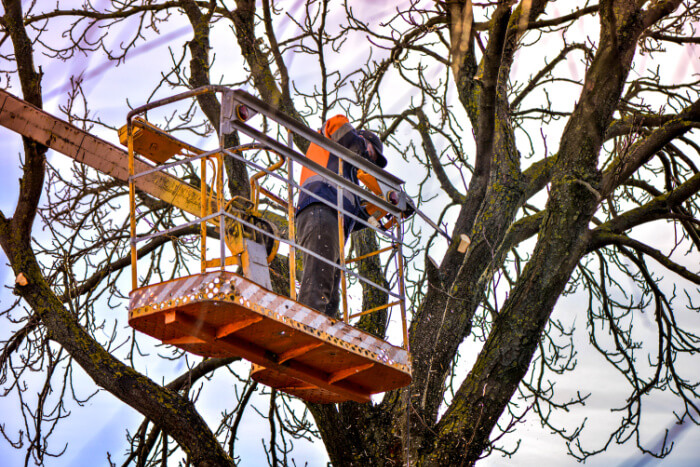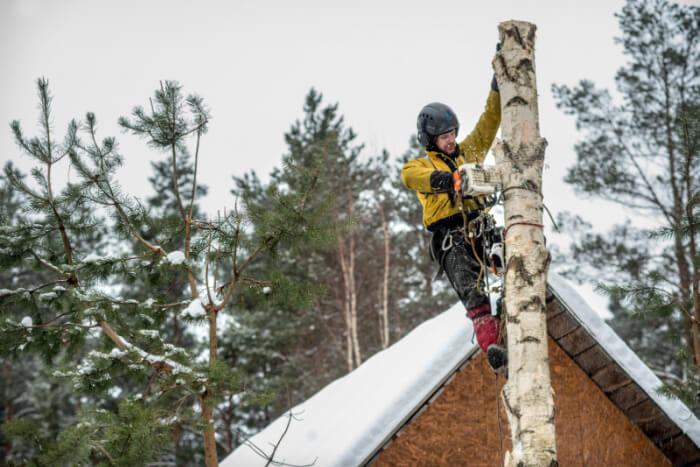Are you doing a tree services project?
Modernize can pair you with three to four pros in your area, so you can compare options and save time and money.
Sitting under the shade of a tree on a hot summer day is a pleasantly picturesque pastime that homeowners are happy to take advantage of. While many people may want trees because of the beauty they provide to a home, they may not think about the maintenance involved in keeping those trees in great condition. Tree trimming — which is the process of removing overgrown branches, as well as those that are dead, diseased, or damaged — can help ensure that your trees continue to look great and remain healthy for a long time.
Why Is Tree Trimming Important?
Tree trimming is important because it helps increase the longevity of trees by promoting healthy growth, preventing disease, and reducing the risk of damage from falling branches.

Maintaining Appearance
Having trees on your property can naturally increase the curb appeal of your home, so you want to make sure that you maintain their beautiful appearance. Without regular tree pruning, this appearance can become compromised as branches sprout in random directions that make a tree look uneven and unkempt. Also, when you learn how to trim trees, you ensure that you can also enjoy the scenery around your house because you don’t have to worry about limbs obstructing views.
Promoting Growth
When trees have sick and dead branches, it hinders the growth of new ones. By tree trimming, you promote the growth of healthy, new branches by removing the old ones so precious nourishment is not wasted on sick areas of the tree. Additionally, any nearby plants and grass experience growth benefits because sun and rain can reach them more readily when excess tree branches are removed.
Improving Tree Health
Parts of trees that are diseased and decaying can put the entire tree at risk because these problems tend to spread. When you prune these parts of a tree, it allows the rest of it to remain healthy and thrive.
Increasing Fruit Production
Just as pruning a tree can pave the way for healthier branches to grow, it can also increase the production of fruit. Since clearing out dead branches allows the healthy parts of the tree, including the fruit, to receive more sunlight and water, this maintenance encourages fruit to grow.
Ensuring Safety
Dangling dead branches will eventually fall off of a tree, and the last thing you want is for them to hit your home, car, or a person who happens to be walking by. This can particularly be a problem during severe storms, so make sure your trees are pruned so heavy winds won’t lead to damage.
Which Plants Require Pruning?
First and foremost, it’s a good idea to prune any plants that have dead and diseased areas so they don’t affect the health of the entire plant. Additionally, the buds of young fruit trees should be pruned because it allows them to grow into their ideal shape. Other plants that can benefit from pruning include topiaries, flowering shrubs, woody perennial herbs, and conifers.
When Is the Best Time to Prune Trees?

Since trees are dormant during the winter months, and are less susceptible to harm from pests, this is the best time to prune trees. Winter also makes it easier to handle the job because there isn’t any new growth that could get in the way, so you’re more likely to cut branches into their ideal shape. Also, pruning trees during the winter allows them to use their stored energy to heal wounds, so by springtime, they’re in a better position to grow in a healthy way.
How Often Should I Trim Trees?
When to prune a tree depends on what type you have. For example, it’s best to prune a fruit tree once a year to ensure that it grows bigger, high-quality fruit. With non-fruit trees, you’ll want to prune them depending on how old they are. Mature trees should be trimmed every three to five years, while young trees should be trimmed every two to three years.
Find the Right Contractor for Your Tree Services Project
Whether you’re ready to begin your project now or need some expert advice, our network of contractors are here to help. With a few simple questions, we’ll find the best local professionals for you
Guide to Trimming Trees
Trimming trees is essential for maintaining their health, appearance, and safety. Before you start, it’s important to have a plan in place and understand the proper techniques to use. Following the right steps will help ensure that your trees remain strong, healthy, and well-shaped.
Choose the Right Tools
To ensure you get the job done correctly, have the right tools available based on the types of branches you’ll be pruning. Hand shears are generally used for small branches that are about one-quarter of an inch in diameter, while lopping shears can be used for branches with a diameter of up to 1.5 inches, and pruning saws are used for branches over 1.5 inches. Also, you can use a chainsaw to effortlessly trim any branches on a tree no matter what size they are.
Make an Assessment
Before beginning the trimming process, you should think about what you want to accomplish. Are there damaged areas you want to remove to maintain the health of the tree? Do you want to reshape it so branches don’t block the sun or views? Are you trying to avoid damage to your home by removing branches that are likely to fall?
Be sure to think about your goals and then imagine the shape and size you’d like to achieve when the trimming is done. Also, identify branches that are part of the tree’s main structure because you don’t want to trim them unless it’s absolutely necessary.
Cut the Branch Underside
When you begin cutting each branch, you want to start with the underside and cut only about four to five inches away from the trunk. This will help ensure that the tree’s bark doesn’t crack when the entire branch is cut and falls from the tree.
Cut Through the Branch
After making the first cut, you will continue by cutting the branch’s top side at a 45-degree angle until both cuts meet and the branch falls off. After this process is complete, a stub will be left behind.
Remove Stub
When you’ve finished cutting a branch, the next step is to remove the stub. To do this, you’ll want to cut what’s left until you see the tree’s stem collar, which is the swollen area that joins a tree’s branch and trunk. Doing this will facilitate the tree’s healing process.
Remove Damaged Branches First
The most important part of pruning is to remove branches that are diseased or damaged by pests or storms, so you want to remove them first. This will help to prevent further damage to the tree.
Thin out other branches. After dealing with the damaged parts of the tree, thin out branches that are densely packed together because they can prevent air circulation and obstruct the sun and rain. Thinning those areas out can help ensure the tree gets the nourishment it needs to stay healthy, as well as clear out any branches that block views.
While it’s important to trim your trees to maintain their health and appearance, avoid excessive pruning, as removing more than 25% of branches can stress and damage the tree. For professional help with tree trimming, Modernize is here to assist. We connect you with top-rated contractors who specialize in tree services, ensuring you find the best expert for your pruning needs.
Find the Right Contractor for Your Tree Services Project
Whether you’re ready to begin your project now or need some expert advice, our network of contractors are here to help. With a few simple questions, we’ll find the best local professionals for you
Reviews from Real Homeowners
Welcome to Homeowner Resources! We are the Modernize blog. Modernize pairs more than 3 million homeowners a year with pre-vetted contractors in their area. This blog started because we believe homeowners should know everything about their homes, from how their HVAC works to which front door colors they might love. On Homeowner Resources, you can find information on every part of your home, right down to how you can negotiate with contractors to get the best price. Here's more about the blog.
Need a contractor? Learn more about how Modernize finds the right pro for you.




